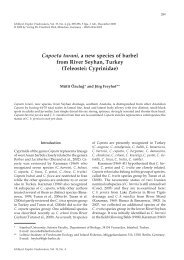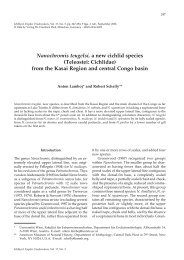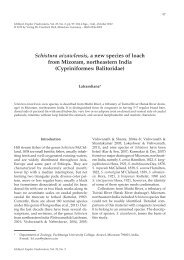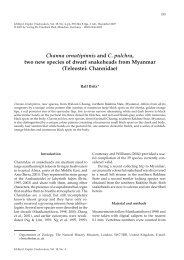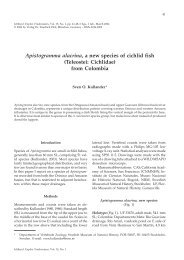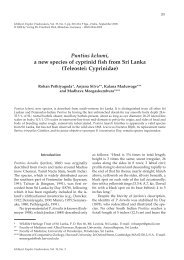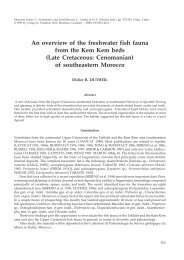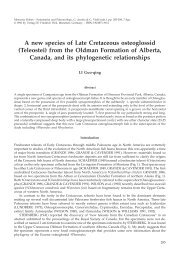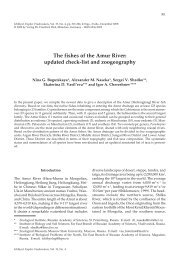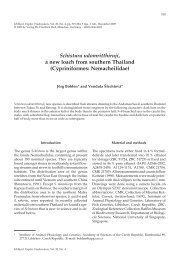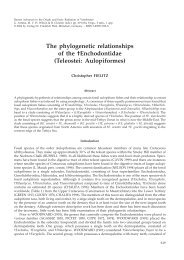A synopsis of the South Asian fishes referred to Puntius - Verlag Dr ...
A synopsis of the South Asian fishes referred to Puntius - Verlag Dr ...
A synopsis of the South Asian fishes referred to Puntius - Verlag Dr ...
Create successful ePaper yourself
Turn your PDF publications into a flip-book with our unique Google optimized e-Paper software.
84<br />
M’Clelland’s (1839) description <strong>of</strong> S. immaculatus<br />
matches that <strong>of</strong> ‘<strong>Puntius</strong>’ sarana (type locality<br />
‘ponds and rivers <strong>of</strong> Bengal’) (Jayaram, 1991;<br />
Talwar & Jhingran, 1991). As shown here (Figs.<br />
1, 6) and corroborated also by Shantakumar &<br />
Vishwanath (2006), ‘P.’ sarana belongs <strong>to</strong> a lineage<br />
distinct from <strong>the</strong> one that includes <strong>Puntius</strong> sophore<br />
(<strong>the</strong> type species <strong>of</strong> <strong>Puntius</strong>): <strong>the</strong> former possess<br />
both rostral and maxillary barbels, a stiff, strongly<br />
serrated last unbranched dorsal-fin ray, a<br />
complete lateral line with 27-34 scales on <strong>the</strong><br />
body, and a horizontally elongate oval black<br />
blotch on <strong>the</strong> caudal peduncle. This adds confidence<br />
<strong>to</strong> our selection <strong>of</strong> a neotype for S. immaculatus<br />
from among specimens nominally<br />
identified as ‘<strong>Puntius</strong> sarana’ from Assam. Sys<strong>to</strong>mus<br />
immaculatus (= S. sarana) may be distinguished<br />
from <strong>the</strong> o<strong>the</strong>r species here included in<br />
Sys<strong>to</strong>mus based on <strong>the</strong> characters provided above<br />
for <strong>the</strong> neotype and <strong>to</strong>potype, and those provided<br />
in <strong>the</strong> works cited in Remarks under <strong>the</strong><br />
diagnosis <strong>of</strong> Sys<strong>to</strong>mus.<br />
Barbodes, Barbonymus and Poropuntius resemble<br />
Sys<strong>to</strong>mus in possessing two pairs <strong>of</strong> barbels<br />
and a serrated last unbranched dorsal-fin ray.<br />
Indeed, Menon (1999) placed S. sarana in Barbodes,<br />
<strong>the</strong> type species <strong>of</strong> which is Barbus maculatus<br />
Valenciennes, in Cuvier & Valenciennes 1842 (see<br />
Kottelat, 1999), which is considered a synonym<br />
<strong>of</strong> B. binotatus Valenciennes, in Cuvier & Valenciennes<br />
1842 (Kottelat, 1999; Pethiyagoda & Kottelat,<br />
2005b). Barbus binotatus, however, differs<br />
from species <strong>of</strong> Sys<strong>to</strong>mus by possessing 23-27<br />
lateral-line scales on body and ½4 scale rows<br />
between <strong>the</strong> dorsal-fin origin and lateral line (vs.<br />
32-33 lateral-line scales and 1 /2 5 scale rows between<br />
<strong>the</strong> dorsal-fin origin and lateral line in<br />
S. immaculatus, <strong>the</strong> type species <strong>of</strong> Sys<strong>to</strong>mus), and<br />
having a distinctive colour pattern (see Kottelat<br />
et al., 1993, pl. 15) not observed in any o<strong>the</strong>r species<br />
here allocated <strong>to</strong> Sys<strong>to</strong>mus s. s. Sys<strong>to</strong>mus differs<br />
from Barbonymus by having fewer than 6 rows <strong>of</strong><br />
scales between <strong>the</strong> dorsal-fin origin and lateral<br />
line (7 or more in Barbonymus); and from Poropuntius<br />
by lacking an accessory pore on <strong>the</strong> canals<br />
<strong>of</strong> <strong>the</strong> lateral-line system (accessory pore present<br />
in Poropuntius: Kottelat et al., 1993; Roberts, 1998;<br />
Kottelat, 2001).<br />
Sou<strong>the</strong>ast <strong>Asian</strong> <strong>Puntius</strong>. The recent literature<br />
refers around 45 species <strong>of</strong> Sou<strong>the</strong>ast <strong>Asian</strong><br />
cyprinids <strong>to</strong> <strong>Puntius</strong>. Only one <strong>of</strong> <strong>the</strong>se, however,<br />
belongs <strong>to</strong> <strong>the</strong> genus as it is now unders<strong>to</strong>od:<br />
P. brevis (Bleeker, 1849). Widespread through<br />
Sou<strong>the</strong>ast Asia (Mekong basin <strong>of</strong> Laos, Thailand<br />
and Cambodia; Chao Phraya basin; Malay peninsula<br />
and Java: Kottelat, 2001) it has <strong>the</strong> last unbranched<br />
dorsal-fin ray smooth, a pair <strong>of</strong> maxillary<br />
(and no rostral) barbels, 23-26 lateral-line<br />
scales and a black spot on <strong>the</strong> caudal peduncle.<br />
Taki et al. (1978) included P. brevis in <strong>the</strong>ir P. binotatus<br />
group, though <strong>the</strong> former species lacks<br />
rostral barbels (present in P. binotatus) and has<br />
<strong>the</strong> last unbranched dorsal-fin ray smooth (vs.<br />
posteriorly serrated).<br />
Only one o<strong>the</strong>r Sou<strong>the</strong>ast <strong>Asian</strong> <strong>Puntius</strong> has<br />
<strong>the</strong> last unbranched dorsal-fin ray smooth, <strong>Puntius</strong><br />
oligolepis (Bleeker, 1853). This species, however,<br />
is distinguished from <strong>Puntius</strong> s.s. by having an<br />
incomplete lateral line, only 17 scales in <strong>the</strong> lateral<br />
series, and 1 /2 3 scale rows between <strong>the</strong> dorsalfin<br />
origin and lateral-line scale row. Its relationships<br />
remain <strong>to</strong> be investigated.<br />
All <strong>the</strong> o<strong>the</strong>r Sou<strong>the</strong>ast <strong>Asian</strong> species presently<br />
<strong>referred</strong> <strong>to</strong> <strong>Puntius</strong> require new generic<br />
assignments. Although this is beyond <strong>the</strong> scope<br />
<strong>of</strong> <strong>the</strong> present work for want <strong>of</strong> material, for<br />
convenience <strong>of</strong> discussion and based on data on<br />
external characters available in <strong>the</strong> literature<br />
(Kottelat et al., 1993; Kottelat, 2001; Rainboth,<br />
1996; Roberts, 1989; Weber & de Beaufort, 1916;<br />
and <strong>the</strong> original species descriptions), we here<br />
refer <strong>the</strong>se <strong>to</strong> a number <strong>of</strong> species groups (see also<br />
Sou<strong>the</strong>ast <strong>Asian</strong> Sys<strong>to</strong>mus, below).<br />
The ‘<strong>Puntius</strong> trifasciatus group’ comprises three<br />
species (P. gemellus Kottelat, 1996, P. johor ensis<br />
(Duncker, 1904), and P. trifasciatus Kottelat, 1996)<br />
distinguished by possessing both rostral and<br />
maxillary barbels, 25-27 scales in <strong>the</strong> lateral line<br />
on body, 7-11 gill rakers on <strong>the</strong> anterior gill arch,<br />
and a juvenile coloration consisting <strong>of</strong> 4-5 black<br />
bars on <strong>the</strong> body, changing <strong>to</strong> 3-6 black stripes<br />
on <strong>the</strong> body as adults (Kottelat, 1996); <strong>the</strong>se characters<br />
combine <strong>to</strong> distinguish <strong>the</strong> members <strong>of</strong> this<br />
group from <strong>Puntius</strong>, Sys<strong>to</strong>mus, Pethia and <strong>Dr</strong>avidia.<br />
The members <strong>of</strong> <strong>the</strong> P. trifasciatus group<br />
appear <strong>to</strong> belong <strong>to</strong> a lineage distinct also from<br />
<strong>the</strong> only o<strong>the</strong>r similarly-coloured species <strong>of</strong> Sou<strong>the</strong>ast<br />
<strong>Asian</strong> ‘<strong>Puntius</strong>’, P. lineatus (Duncker, 1904),<br />
which possess no or only a single pair <strong>of</strong> rudimentary<br />
barbels and <strong>the</strong> adults <strong>of</strong> which have <strong>the</strong><br />
lower lip forming a complete post-labial groove,<br />
distinguishing it from all <strong>Puntius</strong> (in ei<strong>the</strong>r its<br />
previous or present conception). Kottelat (1996)<br />
proposed that it be placed in a separate genus (for<br />
<strong>the</strong> present <strong>referred</strong> <strong>to</strong> as <strong>the</strong> ‘P. lineatus’ group).<br />
Pethiyagoda et al.: Synopsis <strong>of</strong> <strong>South</strong> <strong>Asian</strong> <strong>Puntius</strong>




